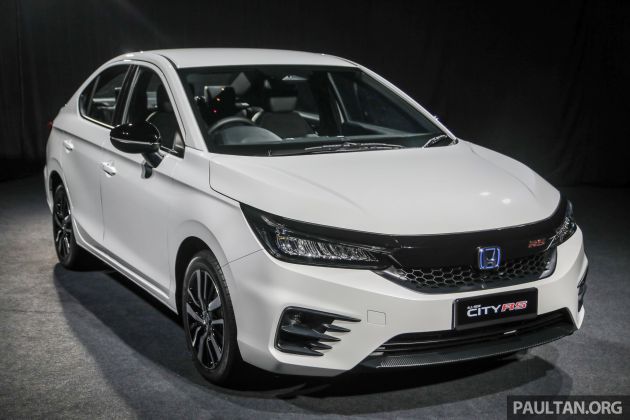2020 Honda City – 5th-gen launched in Malaysia; 1.5L S, E and V; RS e:HEV Hybrid world debut, from RM74k
It has been quite a year in terms of new car launches, and this is despite the ongoing Covid-19 pandemic. The introductions keep coming, and sales are brisk, which bodes well for all of us. One of the biggest and most important debuts of the year happened today, with Honda Malaysia (HM) officially launching the 2020 Honda City.
The new City is available in four variants – the S, E, V and RS e:HEV. The first three grades are 1.5L petrol variants, and they are priced at RM74,191, RM81,664 and RM86,561 respectively. These prices are on-the-road excluding insurance, but with the 2020 sales tax exemption. The RS hybrid has not been given a price yet, as deliveries are only starting in January next year. HM has collected 5,000 bookings for the new City so far and the initial sales target is 3,000 units per month. This will be raised by 500 units once the RS joins the fray in 2021.
The fifth-generation Honda City is all new, and it looks the part as well, being visibly larger than the car it replaces. Compared to the popular fourth-gen B-segment sedan, the new City is 111 mm longer (4,553 mm) and 54 mm wider (1,748 mm). The larger footprint is coupled with a 10 mm lower height, and unchanged wheelbase is 2,600 mm long. The boot capacity is 519 litres – that’s 17 litres less than before (536L) but still class leading.
Let’s start with what’s under the hood. At the top of the range is the City RS e:HEV, which is the hybrid variant starring in the teaser ads and media preview. Unlike before, this latest Hybrid is the costliest variant with all the bells and whistles. By the way, this is a world debut of sorts, as Malaysia is the first country in the world to offer the City with Honda’s two-motor i-MMD hybrid system, which till now was only offered on the latest Jazz in the compact segment. The i-MMD also features in the Accord and CR-V.
Why Malaysia? Obvious, really, when we’re the leading market for the Honda’s hybrids in the Asia-Oceania region, accounting for 40% of sales in the past five years. By the way, much work has gone into HM’s Pegoh plant in Melaka for it to be able to produce cars with the i-MMD hybrid system, and the City RS won’t be the first and last – click here for the full story.
At the heart of the i-MMD system – which replaces the previous generation i-DCD – is a 1.5 litre Atkinson-cycle DOHC i-VTEC engine (98 PS at 5,600 to 6,400 rpm, 127 Nm at 4,500 to 5,000 rpm, 40.5% thermal efficiency is world’s best) , which does not power the car, but functions mainly as a generator with the help of an integrated electric motor, which also acts as a starter.
A larger second motor, which churns out 108 PS and 253 Nm, sends drive to the wheels. Because this “traction motor” drives the car most of the time, the i-MMD system does away with a traditional gearbox, but the engine can provide direct drive at higher speeds using a lock-up clutch and a single-speed transmission (e-CVT) – this is because the ICE is more efficient than an electric motor at high speeds. As the engine has a part time job powering the wheels, this is not a range extender EV system like Nissan’s e-Power.
MMD stands for Multi-Mode Drive, and there are three drive modes. The car always starts off in EV Drive mode, silently. You’ll hear the engine spring to life occasionally to recharge the 1.3 kWh lithium-ion unit locatedbattery, which powers the traction motor. During full acceleration, you’ll enter Hybrid Drive mode. The traction motor is still the main mover here, but the engine will rev higher to pump more juice into the battery. Engine Drive mode happens during high-speed cruising, and this is when the engine takes over from the traction motor to power the wheels.
With the full 253 Nm of torque available from 0 rpm, the City RS will no doubt be very spritely off the line. You would have noted by now HM’s emphasis on this car having more torque than the Toyota Camry, a D-segment sedan with a 2.5L naturally aspirated engine. 0-100 km/h is 9.9 seconds and top speed is 173 km/h. There’s no 0-60 km/h figure, but that should be quite impressive here, like with full EVs. The most important figure for the e:HEV hybrid is FC, and its rated at 3.77 litres per 100 km, or 26.5 km/l.
Like the previous i-DCD system, the air con compressor is an electrically-driven unit, so the AC continues to work when the car is stationary, unlike the IMA hybrid from two generations ago. By the way, the RS e:HEV’s IPU (intelligent power unit) is located at the rear, which reduces boot volume to 409 litres. It also comes with a tyre repair kit in place of a full-size spare wheel. The hybrid tips the scales at 1,246 kg, which is 111 kg more than the heaviest 1.5L, the 1,135 kg V.
The RS may be the one with all the impressive headlining tech, but many would go straight to the conventional variants; like before, there are three of them – S, E and V. These three grades will share the same 1.5 litre naturally-aspirated i-VTEC engine, but the 1.5L is a new DOHC version with 121 PS at 6,600 rpm and 145 Nm at 4,300 rpm. Power goes to the front wheels via a CVT gearbox.
The outgoing car’s SOHC i-VTEC is rated at 120 PS/145 Nm so there’s not much in it in terms of max outputs, but the DOHC is more efficient. The 1.5L’s 0-100 km/h sprint is done in 10.2 seconds for the S and E grades, and 10.4 seconds for the heavier V spec. Top speed is 196 km/h, with the V topping out at 195 km/h. The claimed average fuel consumption is 5.4 litres per 100 km, or 18.5 km/l.
The suspension and brakes are par for the B-segment course – it’s MacPherson struts in front and a torsion beam at the rear, with front ventilated brake discs and rear drum brakes. The RS gets rear discs and an electric parking brake with brake hold function. There are two different alloy rim designs – 15-inch (185/60 tyres) for the S and E (dual-tone for E) and 16-inch (185/55 tyres) for the V and RS (dual-tone for RS).
There’s plenty to cover in the equipment section. LED daytime running lights and LED rear lights are standard across the board, as are power adjustable/retractable wing mirrors with turn signals. As mentioned above, each grade gets its own unique wheel look.
As for the eyes, it’s projector halogens for the S and E, and automatic LED headlamps for the V and RS. Fog lamps (LED) are reserved for the top two, too. The base S and the sporty RS get body colour door handles, while the E and V have chrome ones. Speaking of sporty, the Road Sailing variant (yes, that’s what Honda’s RS stands for) gets an exclusive styling pack that includes a gloss black front grille, gloss black wing mirror caps, boot spoiler in gloss black, “aggressive” fog lamp garnish, carbon-pattern trim on the front lip and rear diffuser, and RS badging.
All grades get keyless entry with push start, rear air con vents, steering audio buttons and Bluetooth (with a call button). Things standard from the E onwards are remote engine start, paddle shifters (deceleration selector paddle for the RS e:HEV), cruise control, single-zone auto air con and an 8.0-inch touchscreen head unit with Apple CarPlay and Android Auto connectivity. The V adds on a leather-wrapped steering and gear knob, leather seats (ivory highlights on door cards, centre tunnel and dashboard) and eight speakers.
RS-only items include a 7.0-inch digital meter panel with hybrid-specific displays, part leather and suede seats, red stitching (steering wheel, gear lever area, centre tunnel and dashboard) and aluminium pedals.
Also exclusive to the RS hybrid is Honda Sensing, which makes its debut in the segment for Honda in Malaysia. The full suite of driver assist and active safety features includes Adaptive Cruise Control (ACC), Collision Mitigation Braking System (CMBS is autonomous emergency braking or AEB), Forward Collision Warning (FCW), Lane Keeping Assist System (LKAS), Road Departure Mitigation (RDM), Lane Departure Warning (LDW) and Auto High-Beam (AHB).


Although the Low Speed Follow function for the ACC is not present here, the Sensing suite on the City is hooked up to wider view stereo cameras (no millimetre wave radar, performs just as well, tested to work in heavy rain) to better recognise road boundaries, and the system now comes with pedestrian and cyclist detection capability. By the way, Sensing’s presence in the City is quite a big deal, as it’s not available in the Thai market City and the next car up to have it in HM’s stable is the top Civic 1.5 TC-P.
Sensing aside, the new City comes with VSA, hill start assist, emergency stop signal and four airbags (dual front and side) as standard. The V and RS add on curtain airbags to make it six in total, and Honda’s LaneWatch left-side camera. All except for the S get a reverse camera hooked up to the centre screen.
There are five to choose from, namely Crystal Black Pearl, Lunar Silver Metallic, Modern Steel Metallic, Passion Red Pearl and Platinum White Pearl. The RS is only available in the three latter colours – grey, red and pearl white. As usual for Honda, there’s a Modulo five-piece bodykit (front/rear under spoiler, side skirts, boot spoiler) going for RM4,473.
Once again, prices for the City S, E and V are RM74,191, RM81,664 and RM86,561 respectively. The cars come with a five-year unlimited mileage warranty with five times free labour service. No price for the RS e:HEV hybrid yet as that will go on sale in January 2021. The hybrid’s lithium-ion battery comes with a separate eight-year unlimited mileage warranty.
GALLERY: 2020 Honda City RS e:HEV 



















































































GALLERY: 2020 Honda City 1.5L V 
















































GALLERY: 2020 Honda City RS e:HEV, outdoor 


























































The post 2020 Honda City – 5th-gen launched in Malaysia; 1.5L S, E and V; RS e:HEV Hybrid world debut, from RM74k appeared first on Paul Tan's Automotive News.
from Paul Tan's Automotive News
Read The Rest:paultan...










Post a Comment